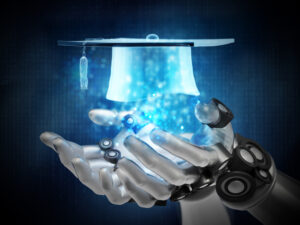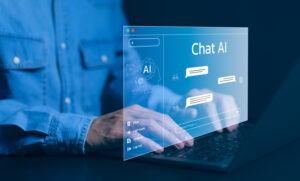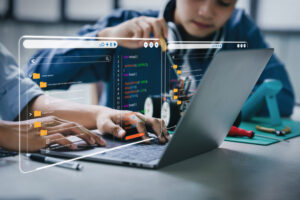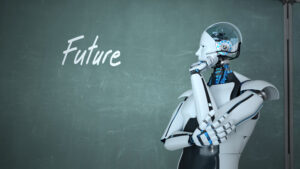Exploring the Impact of AI in Education
When it comes to AI impact on education, teachers are mostly getting the bad parts first. Almost as soon as ChatGPT, the natural language processing, generative pre-trained transformer built by OpenAI, was released, suspiciously well-written homework assignments started landing on teacher’s desks.
Grammatically perfect, and often elegantly structured, they nonetheless often came with errors: factual assertions that were completely made up, or arguments that didn’t quite follow the rules of logic.
Those submissions, written by machines rather than students, often ended in failure.
But the writing is on the wall. At home, in the administration building, and in the classroom, AI is coming to the world of education.
It will be up to teachers to weight the pros and cons of AI in education and ensure it is used to the benefit of their students and not as a replacement for their own thinking.
Artificial Intelligence and Education Will Shape One Another as They Grow Together
 Artificial intelligence has a unique relationship to the educational world. As transformative as artificial intelligence in schools will be, the field of AI itself will also be shaped by the American education system.
Artificial intelligence has a unique relationship to the educational world. As transformative as artificial intelligence in schools will be, the field of AI itself will also be shaped by the American education system.
The road to careers in AI engineering is covered by a lot of schooling. Putting together even basic machine learning algorithms is a process buried deep in core STEM (Science, Technology, Engineering, and Math) skills:
- Advanced mathematics including calculus and linear algebra
- Statistical methods and concepts
- Basic logic and reasoning
- Computer programming
So the people putting together AI for schools will be products of those same schools. The success they have will rest on what they have learned along the way.
Increasingly, AI will be helping teach them those concepts.
What Are Some Examples of AI in Education?
 Artificial intelligence is a blanket term that covers just about any way that machines can be made to approach and solve problems using reasoning and logical skills similar to humans.
Artificial intelligence is a blanket term that covers just about any way that machines can be made to approach and solve problems using reasoning and logical skills similar to humans.
The concept has been around since before World War II, and many practical and theoretical advances occurred in the decades since. But it’s only in the 2020s that the field has really started to achieve something close to the original dream.
The newest and most impressive examples of AI come through generative transformers. Using vast amounts of data, special algorithms are trained to:
- Create or interpret natural language
- Recognize or generate visual images
- Look for deep relationships and connections
This has resulted in AI tools that can write papers, carry on conversations, and paint pictures that are indistinguishable from those produced by humans.
The Benefits of AI in Education May Take a Little While to Uncover
Schools are actually one of the first places where the impressive new capabilities of artificial intelligence have made a mark. After a lot of sensational headlines, just about every school in America now has a policy about using generative AI to do homework.
At the leading edge of AI adoption whether they want to be or not, schools, teachers, and administrators are all feeling the impact of AI on education without a lot of planning or preparation.
Getting up to speed on new concepts and ideas is all part of the role educators play in our society, though. So teachers are quickly starting to think proactively about AI and the future of education.
How AI in Education Will Impact Students
 AI may carry the most promise in education for its ability to precisely tailor lessons to individual students without any extra cost or effort. AI is itself a learning system. It’s quick enough on the uptake that it can develop nearly instant understanding of a student’s capabilities and level of knowledge and adapt lessons to that level. It can also quickly explore different kind of teaching techniques to find the ideal fit for each learner.
AI may carry the most promise in education for its ability to precisely tailor lessons to individual students without any extra cost or effort. AI is itself a learning system. It’s quick enough on the uptake that it can develop nearly instant understanding of a student’s capabilities and level of knowledge and adapt lessons to that level. It can also quickly explore different kind of teaching techniques to find the ideal fit for each learner.
In school systems that are short-staffed, AI can represent a game-changing level of individualized tutoring available to every single student. Any kid having trouble wrapping their head around a particular lesson may turn to a generative AI system that can patiently rephrase and endlessly explain it in different ways until they master it.
On the other hand, AI carries some real risks to the learning experience. AI tools for students may cause them to brush over learning core concepts and techniques that are essential for building more advanced knowledge and skills later on. Students that rely on AI to write essays and do their homework risk never developing the critical thinking and organizational schools that those lessons are meant to build.
AI Tools for Teachers Will Expand Their Ability to Connect to Students
 The initial reaction of most teachers to the emergence of AI in schools hasn’t necessarily been positive. To be fair, their first exposure has often come through suspiciously well-written papers or over-explained homework assignments from students not clever enough to cover their tracks.
The initial reaction of most teachers to the emergence of AI in schools hasn’t necessarily been positive. To be fair, their first exposure has often come through suspiciously well-written papers or over-explained homework assignments from students not clever enough to cover their tracks.
But AI for teachers can represent something more than just a new way of cheating to be guarded against. As a mirror to the ways that AI can be used to help students in the classroom, it can dramatically increase the impact of any teacher who uses it.
They can tailor AI agents to work on exactly the points that each individual student needs, without spending extra class time on all of those topics.
AI can work to get individual kids up to speed without the entire class having to detour through topics already covered and absorbed by most.
That can keep classes fun, fast, and interesting without leaving any student behind.
The Benefits of AI Tools Come From Outside the Classroom in Lesson Planning and Grading
 On the same note, AI can do a lot of the crunch work in lesson planning and grading.
On the same note, AI can do a lot of the crunch work in lesson planning and grading.
A lot of teaching is basically content creation: curriculum consists of a lot of words and illustrations designed to get concepts across. This is something that generative AI excels at. Prompted by an expert educator, it can spin accurate images, captivating paragraphs, and logical quizzes almost instantly.
Generative AI is tailor-made for creating clear and easy-to-understand text of the kind that characterizes good learning material.
Moreover, it can do so with a specific focus on the students who will be studying those lessons. Imagine a lesson plan with the same core content, tailored to 30 different students. Each lesson can be tailored to their learning style and preferences. For non-native speakers, it can be in their own language. And all of it without any additional effort from the teacher.
AI may be able to grade the homework on those same plans just as easily. Just as importantly, it can give updates on progress along the way, watching how students work. That puts teachers in the picture early when learning impediments come into play. Fewer kids will fall behind and educators can spend more time on big-picture goals and achievements.
Will generative AI in education someday replace teachers entirely? When you have an AI-generated curriculum plan and AI that can directly interact with students and walk them through material and answer questions about it, that’s an open question. The future of AI in education is still unwritten. It will be this generation of educators that determines the eventual role of artificial intelligence in education in America.
AI in School Administration Will Change How Schools Are Run
 Naturally, such big changes in the classrooms will have big changes for schools themselves. Under-resourced schools may suddenly have an easier time catching up and improving test scores. Hiring crunches will ease as AI can take the place of empty positions.
Naturally, such big changes in the classrooms will have big changes for schools themselves. Under-resourced schools may suddenly have an easier time catching up and improving test scores. Hiring crunches will ease as AI can take the place of empty positions.
AI tools also have a lot of potential to handle the more typical kinds of paperwork and administrative overhead that schools share with any kind of organization
Process automation run by artificial intelligence can take the load off educational administration office staff.
Even something as basic as taking attendance can quickly and easily be switched over to AI. School camera systems plus advanced computer image recognition means there is no need for teachers to take time out of teaching to see who is there and who isn’t. The system will instantly let the office know of any absences.
And if that absence is excused, it may be done by a parent calling in to an AI voice recognition system and simply telling it their child will be out that day. The system will be able to recognize the parent’s voice, connect it to the attendance records, and ensure that the absence is marked as excused.
Of course, similar systems will make scheduling a breeze for kids who want to work out the optimal class schedule. No school counselors need to get involved; the AI can figure out the best way to fit in both orchestra and Spanish II.
Further up the administrative chain, school leaders will make use of predictive AI tools to anticipate school needs. Using volumes of historic data, AI can offer insights and analytics to help with planning for everything from enrollment to school lunches.
A Look at Current Tools and Applications With AI for Education
For some of these applications, the future of artificial intelligence in education is now.
Teachers and educational leaders can already tap into commercially-available AI-powered tools that handle tasks like:
- Quiz generation
- Personalized English lesson planning
- IEP (Individualized Education Program) creation
- Student assessment creation
- Report writing
Many teachers are also simply using off-the-shelf general chatbots like ChatGPT in schools. As a model trained on the wealth of existing material from the internet and libraries, it’s not a bad resource for all kinds of general history, social studies, and even science education. In fact, OpenAI, the company behind ChatGPT, has even released a guide for teachers using the chatbot as a teaching tool… as well as advice for detecting AI-driven plagiarism and cheating.
Text-to-image generators like Canva are also in common use by educators. Many students are visual learners. Tough theoretical concepts come across more easily to them when offered as an illustration or diagram. Teachers can generate those images directly today without having to dig through old textbooks for examples.
There are also dedicated lesson development tools coming out like Eduaide that offer a more holistic approach to lesson planning driven by AI.
Artificial Intelligence in Education Challenges Will Shift Along With the Benefits
 Focused on the future and creating a better tomorrow, teachers are naturally pretty positive people. Despite some of the early exposure of ChatGPT in education as a tool for cheating, many educators can see the positive potential uses of such tools.
Focused on the future and creating a better tomorrow, teachers are naturally pretty positive people. Despite some of the early exposure of ChatGPT in education as a tool for cheating, many educators can see the positive potential uses of such tools.
But there will be many challenges that come along with adopting education and AI to fit together. Teachers will be the individuals responsible for both identifying the issues and coming up with the solutions.
Will Education AI Actually Impair Learning Abilities?
One model for looking at AI is by comparing it to a calculator. Used properly, calculators can give students a boost in higher-level maths and physics by performing basic operations quickly and accurately. They can get to the parts of advanced lessons that really matter without being bogged down in fundamentals.
But if used to short-circuit their learning of those fundamentals in the first place, calculators become a problem. If they don’t build a strong mental model of multiplication or long division, it becomes very difficult to later teach them advanced algebra or calculus.
So the use of AI will have to be carefully weighed and monitored to keep from displacing essential foundational lessons.
The Ethics and Privacy of AI in Schools Is Still Under Debate
 AI in classrooms also brings new issues of ethics, bias, and privacy along with it.
AI in classrooms also brings new issues of ethics, bias, and privacy along with it.
For example, most educators probably felt a little twinge of concern when the read the section above about automated attendance taking by AI camera systems in schools. Although cameras are already everywhere both in and outside American schools, the level of surveillance that AI can bring is a cause for concern.
Today, if someone wants to know where a student or teacher has been over the course of a day, it requires sitting down and reviewing hours of footage directly. With AI and facial recognition systems in place, it’s a simple matter of asking the system for a detailed itinerary of where they were—and maybe even what exactly they were doing in each place, as the system learns how to recognize behaviors.
AI will offer unprecedented insight into student and teacher performance… which might not always be welcome by either.
It’s just as easy to get that summary for a week, a month, or a year. And that will bring real privacy concerns… as well as potential security issues, if such information fell into the hands of bad actors.
Those privacy concerns only increase when you consider the amount of information AI will absorb about individual student performance. Over the course of the scholastic career of a preschooler starting in 2026 or so, every classroom question, every test score, and every homework assignment will be fed into a machine somewhere building a detailed profile of their intellectual capacity and personal behavior.
It’s hard to say what use that information might be put to eventually. Yet the very fact that it’s hard to say also makes it a matter of real concern.
AI Bias Can Lead to Setbacks in Educational Use
 AI has a history of incorporating human bias into its behavior that should give all teachers a pause when considering how it could be used in schools. Educators already have to work against years and years of systemic bias against minority students. Unless it’s used very carefully, AI could simply perpetuate that system.
AI has a history of incorporating human bias into its behavior that should give all teachers a pause when considering how it could be used in schools. Educators already have to work against years and years of systemic bias against minority students. Unless it’s used very carefully, AI could simply perpetuate that system.
Worse yet, it could do so without being easily detectable. If individualized instruction becomes common, it may be impossible for teachers to closely monitor what conversations occur between AI and each student. Would they notice if AI started nudging students of color toward jobs in manual labor versus college, because their training data shows more examples of that?
Since many advanced tasks in grading involve interpretation, there is a lot of room for AI to incorporate various biases into that task, as well.
Artificial Intelligence and the Future of Teaching and Learning
 Artificial intelligence in the classroom and school administration may be one of the most profound changes that the education system will ever experience. In society as a whole, experts are already comparing it to the invention of electricity.
Artificial intelligence in the classroom and school administration may be one of the most profound changes that the education system will ever experience. In society as a whole, experts are already comparing it to the invention of electricity.
We’re not there yet. But as fast as ChatGPT is trickling out into the daily considerations of teachers, it’s easy to see how huge changes are looming on the horizon.
Even if machine learning is a way of taking education to the smooth silicon pathways of robot brains, education will still be a very human activity, however. While plenty of tasks and decisions will no doubt be outsourced, human judgement and expertise are things that can never go out of style.
That means that degrees in education will still be an important way that teachers are prepared for any role in the future of schools. With a strong basis in problem solving and liberal arts, studies of education are what allow adaptation to even changes as dramatic as AI in classrooms.
